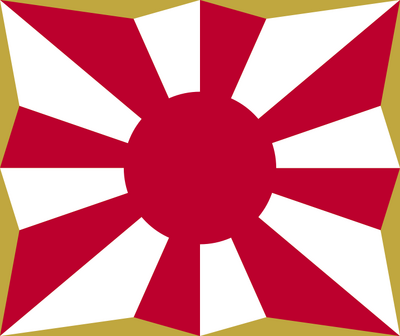The Japan Self-Defense Forces (自衛隊 Jieitai?), or JSDF, occasionally referred to as JSF or SDF, are the unified military forces of Japan that were established after the end of the post–World War II Allied occupation of Japan. For most of the post-war period the JSDF was confined to the islands of Japan and not permitted to be deployed abroad. In recent years they have been engaged in international peacekeeping operations.[7] Recent tensions, particularly with North Korea,[8] have reignited the debate over the status of the JSDF and its relation to Japanese society.[9] New military guidelines, announced in December 2010, will direct the Jieitai away from its Cold War focus on Russia to a focus on China, especially regarding the dispute over the Senkaku Islands.[10]
History[]
The JSDF numbered 239,430 in 2005 with 147,737 in the Ground Self-Defense Force, 44,327 in the Maritime Self-Defense Force, 45,517 in the Air Self-Defense Force, and 1,849 in the Joint Staff Office. Reserves numbered 57,899.
The Prime Minister is the commander-in-chief of the Self Defense Forces. Military authority runs from the Prime Minister to the cabinet-level Minister of Defense of the Japanese Ministry of Defense.A[12][13][14][15]
The Prime Minister and Minister of Defense are advised by the Chief of Staff of the Joint Staff Council, consisting of the Japan Ground Self-Defense Force (GSDF), the Japan Maritime Self-Defense Force (MSDF), and the Japan Air Self-Defense Force (ASDF). The Chief of Staff is a 4-star General or Admiral, is the highest ranking military officer in the Japan Self Defense Forces and the Operational Authority over the Japan Self Defense Forces, with directions from the Prime Minister through the Minister of Defense.[15][16] The Chief of Staff would assume command in the event of a war, but his or her powers are limited to policy formation and defense coordination during peacetime.[12][13]
The chain of Operational Authority runs from the Chief of Staff of the Joint Chiefs of Staff (統合幕僚会議 Tōgōo Bakuryō Kaigi?) to the Commanders of the several Operational Commands. The service Chief
Imperial Japanese armed forces' conduct up to Japan's defeat in World War II had a profound and lasting impact on the nation's attitudes toward wars, armed forces, and military involvement in politics. These attitudes were immediately apparent in the public's acceptance of not only the total disarmament, demobilization and the purge of all the military leaders from positions of public influence after the war, but also the constitutional ban on any rearmament. Under General Douglas MacArthur of the United States Army, serving as the Supreme Commander of the Allied Powers, the Allied occupation authorities were committed to the demilitarization and democratization of Japan. All clubs, schools, and societies associated with the military and martial skills were eliminated. Martial arts were banned. The general staff was abolished, along with army, navy ministries, the Imperial Army and Imperial Navy. Industries serving the military were also dismantled.[citation needed]
The trauma of the lost war had produced strong pacifist sentiments among the nation, that found expression in the United States-written 1947 constitution, which, under Article 9, forever renounces war as an instrument for settling international disputes and declares that Japan will never again maintain "land, sea, or air forces or other war potential".[citation needed] Later cabinets interpreted these provisions as not denying the nation the inherent right to self-defense and, with the encouragement of the United States, developed the SDF step by step. Antimilitarist public opinion, however, remained a force to be reckoned with on any defense-related issue. The constitutional legitimacy of the SDF was challenged well into the 1970s, and even in the 1980s, the government acted warily on defense matters lest residual antimilitarism be aggravated and a backlash result.
Units[]
- Five armies,
- Five maritime districts, and
- Three air defense forces.
The result has been a unique military system. All SDF personnel are technically civilians: those in uniform are classified as special civil servants and are subordinate to the ordinary civil servants who run the Ministry of Defense.[citation needed] There are no military secrets, military laws, or offenses committed by military personnel; whether on-base or off-base, on-duty or off-duty, of a military or non-military nature, are all adjudicated under normal procedures by civil courts in appropriate jurisdictions.
